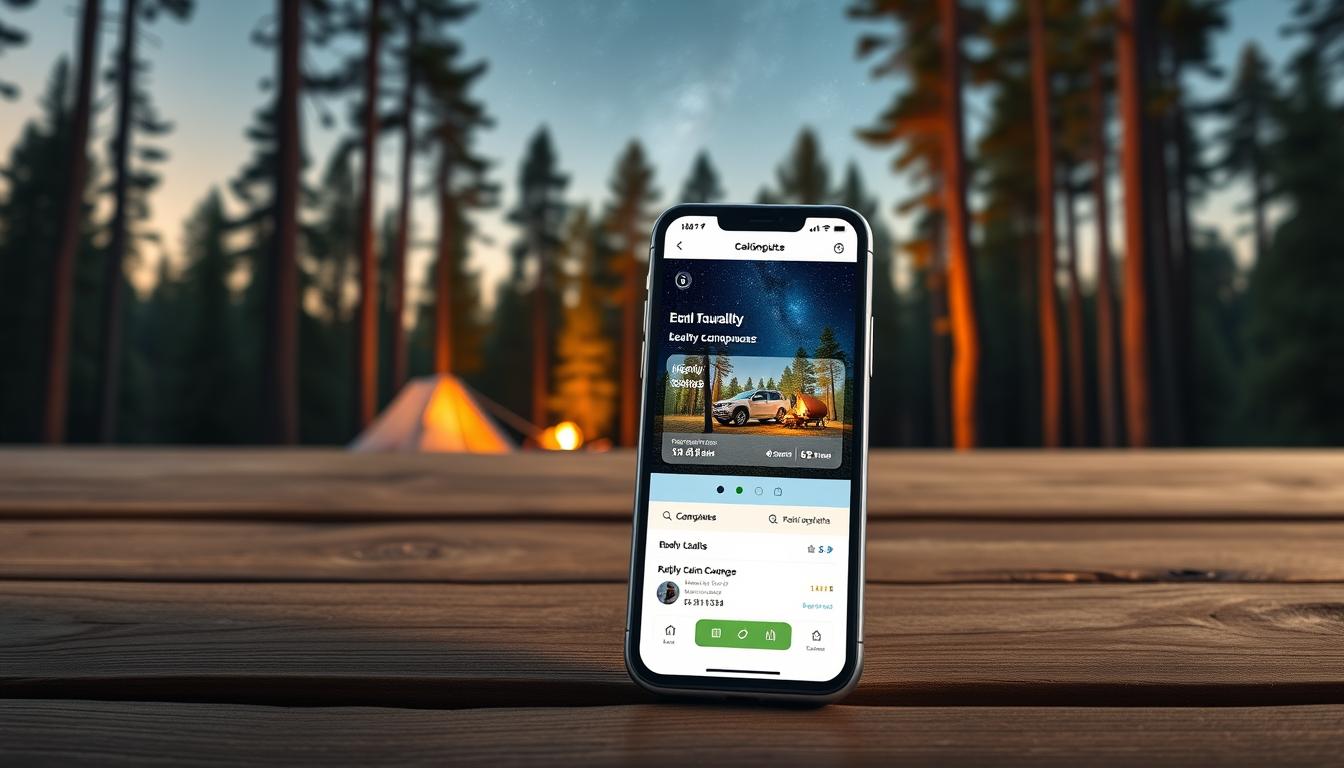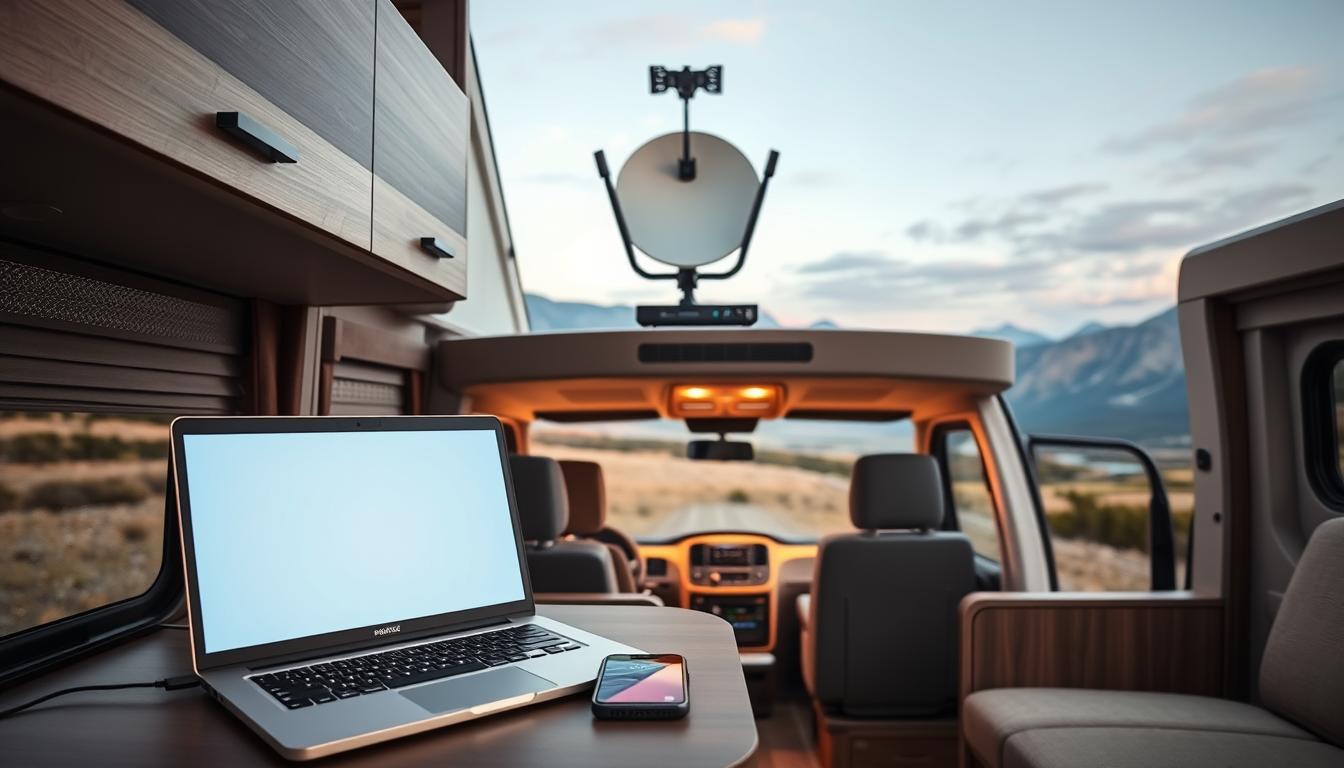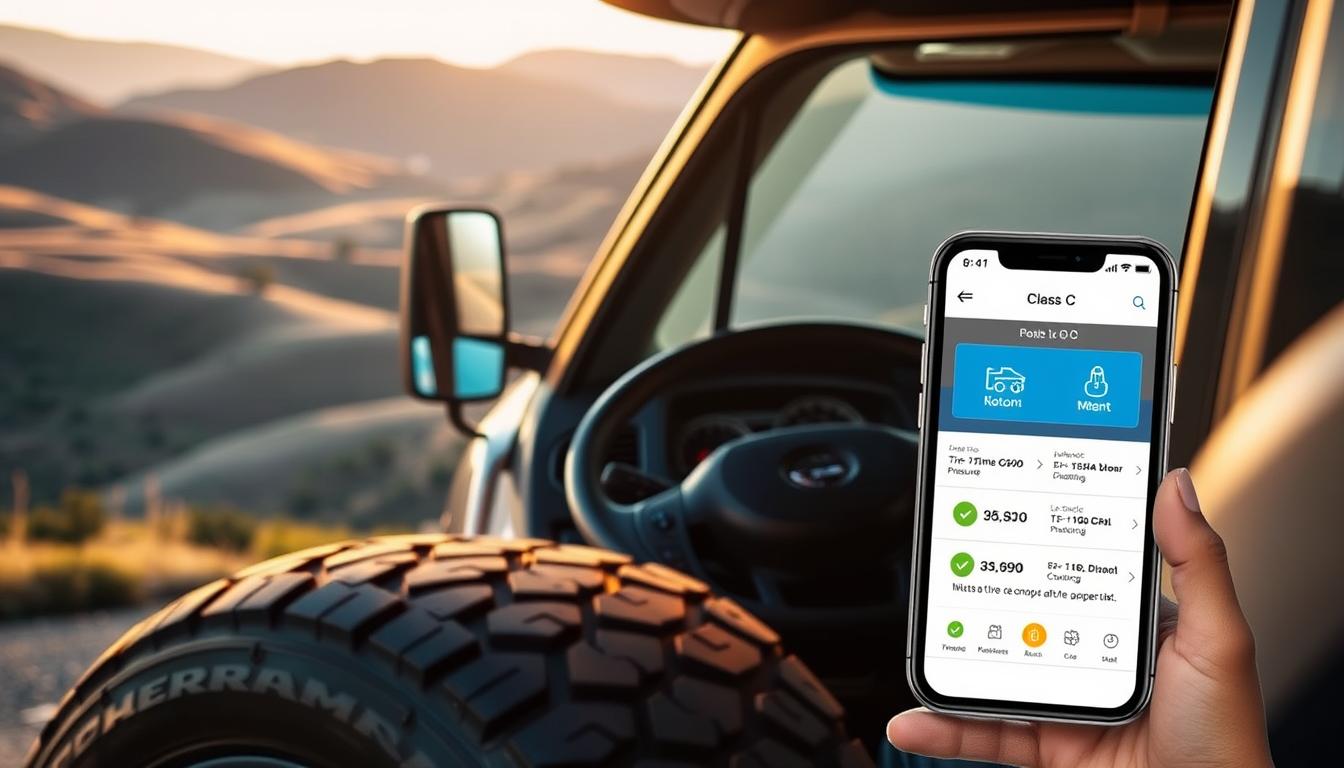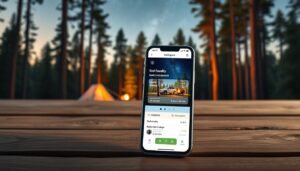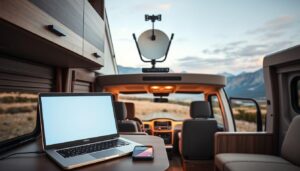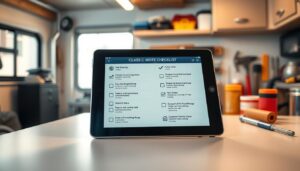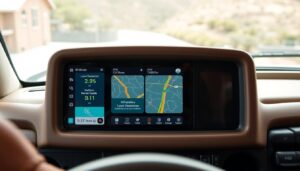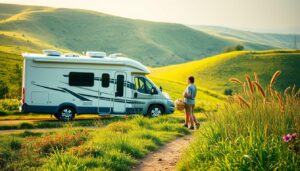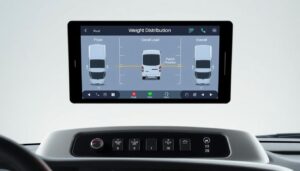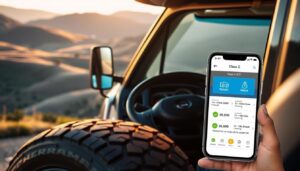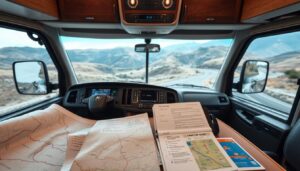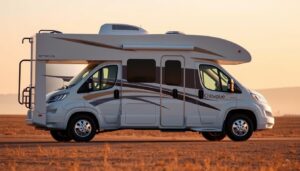Apps to help monitor and refill potable water in your Class C motorhome
Ever found yourself without drinking water on a Class C motorhome trip? Managing water levels is key for RV travelers. With mobile tech advancing, apps for managing water in Class C motorhomes are changing the game. These apps track water use and make refilling easy, keeping you hydrated on the go.
Introduction to Potable Water Management in Your RV
Knowing how to manage water in your RV is crucial for a comfortable trip. It ensures you always have clean drinking water. This makes your journey more enjoyable. With good water management, you can plan your trip better, knowing when to refill your water.
Every RV has a water system designed for its users. Learning about these systems improves your travel experience. It saves time and effort. Knowing about tank sizes and filtration options is essential.
Importance of Monitoring Potable Water Levels
Keeping track of water levels is key for RV lovers. It helps avoid water shortages and makes trips more enjoyable. Knowing your RV’s water capacity helps plan water use, preventing surprises on the road.
Why Accurate Water Level Monitoring is Crucial
Knowing your water supply is important for road trips. Many RVs have built-in systems that might not always be right. Changes in temperature and pressure can mess with these systems.
Regular checks can prevent water management problems.
Understanding Your RV’s Fresh Water Capacity
RVs hold between 20 to 100 gallons of water, depending on the model. Knowing this is crucial for planning and managing water use. It ensures you have enough for showers, cooking, and cleaning.
For more tips on managing water in your motorhome, check out this resource.
Overview of Class C Motorhome Water Systems
Class C motorhomes have complex water systems to make travel better. They have tanks for fresh, gray, and black water. Each tank has its own role.
The fresh water tank is key for drinking, cooking, and cleaning. It’s the main water source in the RV. It often has pumps for showering and washing dishes. Knowing the tank’s size helps manage water use.
Gray water tanks hold wastewater from sinks and showers. They keep the RV clean by separating wastewater. It’s important to check these tanks often to avoid spills and keep things sanitary.
The black water tank holds toilet waste. It’s vital for keeping the RV clean. Knowing how to use these tanks is crucial for emptying them at the right time.
| Type of Tank | Function | Typical Capacity (Gallons) |
|---|---|---|
| Fresh Water Tank | Stores potable water for daily use | 30-60 |
| Gray Water Tank | Collects waste from sinks and showers | 20-40 |
| Black Water Tank | Stores toilet waste | 20-30 |
Knowing how these water systems work in a Class C motorhome is key for a good trip. It helps travelers use water wisely, making their journey more comfortable.
Apps to Manage Potable Water in Class C Motorhome
Managing water in a Class C motorhome is easier with new apps. These RV apps help track water levels, remind you to refill, and alert you to problems. They make RVing better by keeping your water clean. Let’s look at these features and review top apps for RVing.
Key Features to Look For
When picking water management apps, look for these key features:
- Tank Level Monitoring: It tracks water levels so you refill on time.
- Filling Reminders: It sends you notifications to avoid running out of water.
- Overall Alerts: It warns you about leaks or other issues right away.
- Usage Tracking: It shows how much water you use each day, helping you save.
Popular Apps Review
Many apps make managing water in RVs better. Here’s a quick look at some top ones:
| App Name | Features | Compatibility | Rating |
|---|---|---|---|
| HYMER Connect | Tank monitoring, remote alerts, usage tracking | iOS, Android | 4.8/5 |
| RV Water Manager | Refill reminders, leak alerts | iOS | 4.5/5 |
| Camper’s Companion | Usage history, filling reminders | Android | 4.6/5 |
Choosing the right app makes managing water in your Class C motorhome easy. The features and apps we talked about make RV trips more fun. Using tech to keep an eye on your water supply makes RVing better, giving you the resources you need to enjoy the outdoors.
How to Use Apps for Efficient Water Refilling
RV apps make water refilling easier and improve your travel. They offer features to help manage water, especially for RV users. Here’s how to use these tools for efficient refilling.
Step-by-Step Guide to Using Water Management Apps
- Download the App: Choose a water management app for RVs. Look for ones with good reviews.
- Set Up Your Profile: Enter your RV’s details, like tank size and water use. This helps the app plan better.
- Locate Water Refilling Stations: Use the app’s map to find water stations. Many apps have reviews to help you pick the best ones.
- Plan Your Refilling Schedule: Set reminders in the app for when to refill. This is based on your travel plans.
- Monitor Consumption: Track how much water you use. This helps plan your next refill.
- Evaluate Filling Times: Note how long it takes to refill. This can help you find faster stations.
- Adjust Preferences: Most apps let you customize alerts. Set them to remind you to refill at the right time.
Understanding RV Water Tank Capacities and Usage
Knowing about RV water tank sizes and daily water usage is key for a great RV trip. It helps RVers manage their water well and enjoy their travels more.
Typical Fresh Water Tank Sizes in Class C RVs
Class C motorhomes come with different water tank sizes to meet various needs. Here are some common sizes:
| Tank Size (Gallons) | Common Usage |
|---|---|
| 20 Gallons | Suitable for short trips or minimal water needs |
| 50 Gallons | Ideal for medium-length trips with a modest group |
| 100 Gallons | Best for extended travel or larger families |
Daily Water Usage Estimation While Traveling
Knowing how much water you use each day is crucial for planning. Here’s a breakdown of daily water use:
- Showering: 6-10 gallons per person
- Dishwashing: 3-5 gallons
- Cooking and drinking: 1-2 gallons
- Toilet flushing: 1-2 gallons per flush
This helps show why understanding RV water tank sizes and daily use is important. With good planning and regular checks, RV trips can be smooth and enjoyable.

Common Water Refilling Challenges in Class C Motorhomes
Refilling water in Class C motorhomes can be tricky. Slow filling times often come from back pressure in the water lines. This can be really frustrating.
Also, faulty connectors can cause leaks or stop the water flow. These problems can delay your trip or camping plans.
Making mistakes while refilling can make things worse. Not connecting hoses right or guessing tank sizes are common errors. Knowing these issues helps find better solutions.
Using digital tools to track water levels can be very helpful. It’s a great way to manage these common problems in Class C motorhomes.
Benefits of Using Digital Solutions for Water Management
Using digital solutions for RV water management offers many advantages. These tools make it easier to keep an eye on water levels. This way, you always have enough fresh water when you’re on the move.
Apps help RV owners track their water levels and send alerts when it’s time to refill. This approach helps avoid waste and promotes using resources wisely. It makes your RV trips more enjoyable and stress-free.
Adding technology to water management improves its function and planning. It’s great for both experienced and new RVers. The benefits of apps make them a must-have for RV enthusiasts.
Water Conservation Tips While Boondocking
Boondocking lets RVers enjoy nature but needs careful water planning. Using water wisely makes your supply last longer. Here are some tips for saving water and reusing RV water.
How to Reduce Water Usage
Making small changes in your daily life can save a lot of water. Try these tips:
- Navy showers: Stop the water while you soap up. This can save a lot of water per shower.
- Wash dishes efficiently: Use a basin to rinse dishes instead of running water. This saves water and is better for the environment.
- Limit laundry: Only do laundry when you really need to. Use the shortest wash cycle possible.
- Shorten cooking times: Choose meals that use less water, like one-pot dishes.
Reusing Water to Extend Supply
Using RV water again can be a big help in remote areas. Here are ways to make your water last longer:
- Gray water systems: Some RVs let you use gray water for irrigation or cleaning. Check if your RV is compatible.
- Collect rainwater: If it rains where you are, use containers to catch water. It’s great for non-drinking uses.
- Filter and purify gray water: Get a system that makes gray water safe for other uses.
Integrating Smart Home Technology with Your RV
Smart home tech changes how RV fans manage their mobile homes, especially with smart water management. It makes life easier and lets you control water levels and use. You can use voice commands or apps on your phone to check your RV’s water, just like in a regular house.
Adding these smart features to RVs keeps travelers in the loop about their water. For example, you get alerts when your tanks are almost empty. This way, you can refill them without having to check manually. It’s a smart way to use resources and avoid wasting water.
Also, smart water systems learn your habits and adjust to save more water. This means RVers can enjoy the outdoors more comfortably and efficiently. It’s a big step forward in RV living.
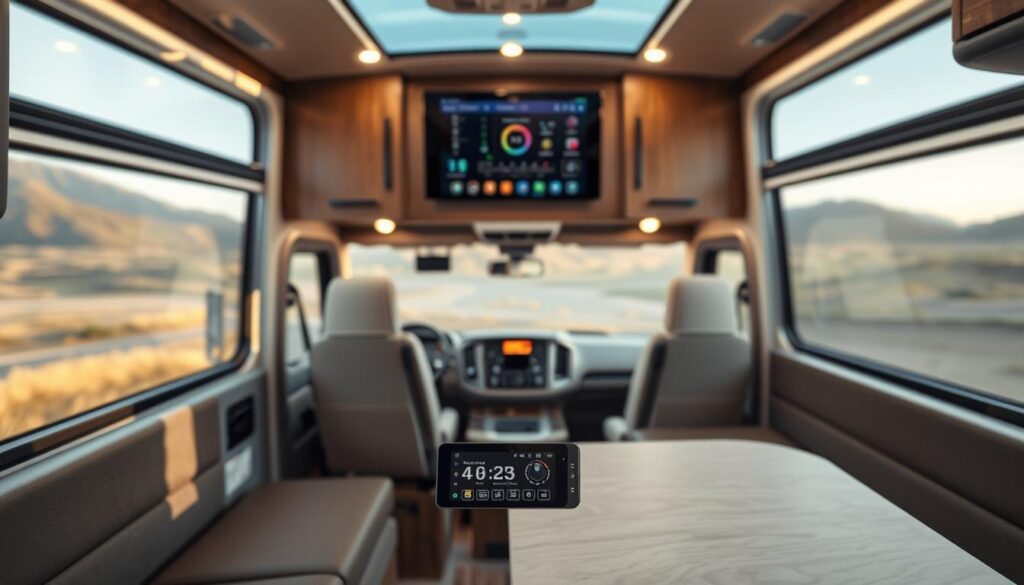
Brands that Offer Smart Water Management Solutions
RV lovers are looking for better ways to handle their water systems. Several smart water management brands are leading the way. They use advanced RV technology to create innovative solutions for Class C motorhomes.
These brands offer tools to help users keep track of their water systems. This makes managing water easier and more efficient.
Notable Motorhome Manufacturers’ Technology Advances
Water management technology is key for RV owners. HYMER and Fleetwood are at the forefront with their innovations. They provide solutions that make tracking water levels more accurate and easy to use.
Here’s a look at how these brands have improved their products:
| Brand | Key Features | Benefit to Users |
|---|---|---|
| HYMER | Integrated water monitoring systems, real-time data alerts | Improved accuracy in tracking water levels, reduces the risk of overflow |
| Fleetwood | Smart tank sensors, user-friendly app interfaces | Easy access to water usage information, enhances user experience |
| Tiffin | Smart display dashboards, remote monitoring capability | Convenience and peace of mind while on the road |
| Winnebago | Automatic refilling systems, integrated RV technology | Streamlined water management, reduces manual refilling tasks |
These advancements mark a shift towards smarter water management in RVs. As technology keeps improving, we can expect even better features for managing water. This will lead to a better RV experience for everyone.
Safe Practices for Potable Water Filling
Filling your RV’s water tanks safely is key. Always check the water source first. Make sure it’s clean and reliable. This is crucial for keeping your water safe.
Before filling, inspect your hoses and connectors. Damaged or dirty hoses can harm your water. Regular cleaning and maintenance are important for safe water.
Using a water filter is also a good idea. It removes harmful bacteria and pollutants. This ensures your water is safe to drink. Following RV filling tips can also make the process easier.
Try to fill your tank in a clean, well-lit area. Avoid touching surfaces that might be contaminated. By following these steps, you can enjoy clean water on your travels.
User Experiences with Water Management Apps
Water management apps play a big role in RV life. Users love how these apps make tracking water easy and help them refill on time. They say these tools reduce stress about running out of water while traveling.
But, there are some problems. Like when apps don’t work because of bad signals in remote spots. This can be really frustrating. Still, most RV fans think the good stuff these apps offer is worth it.
People’s experiences with these apps are mixed. Some love the ease and peace of mind they bring. By using these apps, RV owners can manage their water better. This makes their trips more fun and less stressful.
| App Name | User Ratings | Common Feedback |
|---|---|---|
| AquaCheck | 4.7/5 | Reliable tracking and easy to use |
| Water Watch | 4.5/5 | Informative stats but connectivity issues |
| FreshWater Log | 4.8/5 | Best for monitoring multi-tank systems |
Conclusion
Managing potable water is key for comfort and convenience in Class C motorhomes. RV apps help by tracking water levels and refilling when needed. Today’s technology makes traveling easier, letting RVers enjoy their journey without water worries.
When you go on your next trip, using these tools makes managing water easier and greener. RV apps help you keep an eye on your water and refill it without hassle. This technology changes how RVers enjoy the road.
Using these new solutions is important for stress-free travel. With good water management, you can focus on making memories and exploring new places. RV travel is all about freedom and adventure.
FAQ
What is the significance of managing potable water in Class C motorhomes?
Managing potable water is key for a great RV trip. It lets travelers enjoy their adventures and stay comfortable on the road.
How can I monitor my potable water levels accurately?
Use water management apps for RVs. Also, know your motorhome’s tank sizes, which range from 20 to 100 gallons.
What are the different types of water tanks in Class C motorhomes?
Class C motorhomes have three water tanks. There’s fresh water, gray water, and black water. Each is vital for daily life and travel.
What features should I look for in water management apps?
Look for tank level tracking, reminders, alerts, and smart home integration. These features make managing water easier.
Can you suggest any popular water management apps for RVers?
HYMER Connect is a top choice for RV owners. It’s easy to use and has great features for tracking and refilling water.
How can I use water management apps to refill my potable water efficiently?
Follow the app’s guide for tracking and refilling. It also offers tips for common issues like slow filling and connectivity problems.
What are some common tank sizes in Class C motorhomes?
Tank sizes vary from 20 to 100 gallons. This helps RVers plan their water use for daily activities like showering and washing dishes.
What challenges might I face when refilling my potable water tanks?
You might face slow filling, faulty connectors, and user mistakes. But, apps and digital tools can help solve these problems.
What are the benefits of using digital solutions for water management?
Digital solutions save time and prevent water shortages. They help keep water levels right and reduce waste, making RV trips more efficient.
What water conservation tips can I use while boondocking?
Try navy showers, reuse gray water, and use campsite facilities. These tips can stretch your water supply while boondocking.
How can I integrate smart home technology for better water management in my RV?
Use smart home features like voice control and apps. They make monitoring and using water in your motorhome easier.
Which brands offer innovative water management solutions for Class C motorhomes?
HYMER and Fleetwood lead in water management tech. Their innovations improve the RV experience.
What safe practices should I follow when filling potable water tanks?
Always check hoses and connectors for cleanliness. Make sure the water source is safe. Use proper filling techniques to avoid contamination.
What have other users experienced with water management apps?
Users share both successes and challenges with water apps. They find benefits like better monitoring, water saving, and easier refilling.


